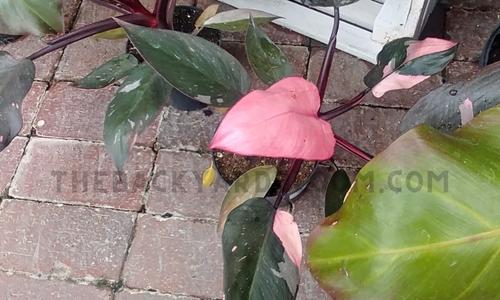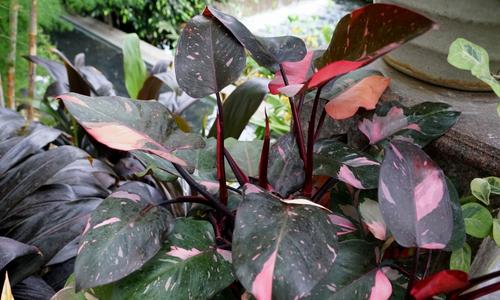Please note that this post may contain affiliate links. You can read my full affiliate disclosure at the bottom of the page.
The Philodendron Pink Princes is a very unique looking Philodendron that is a climber. It has stunning and eye-catching pink variegation on its dark green leaves. Like the Philodendron White Princess its unique look makes it stand out and also makes it a very desirable plant among Philodendron collectors. They can be easy to care for if you have the right conditions available in your house for the plant. They need higher temperatures than most plants to thrive and high humidity levels. Read on to see how to care for a Philodendron Pink Princess plant.
Origin
The Philodendron Pink Princess is a hybrid philodendron cultivar that is known for its unique pink variegation with dark green leaves. It is a cultivar of the Philodendron erubescens which originates in Colombia.
Philodendron Pink Princess Scientific Name: Philodendron erubescens ‘Pink Princess’
Other Names
- Pink Princess Philodendron

Quick Overview Of How to Care For a Philodendron Pink Princess
- Bright indirect light, avoid midday sunlight.
- Water once the top few inches of soil have dried out and avoid overwatering.
- Use a barky aroid soil mix and moss pole for it to climb up.
- Temperature: between 65°F and 85°F.
- Humidity greater than 50%.
- Use a pot that allows for drainage.
- Toxic to pets.
Other Philodendron Care Guides:
- Philodendron Melinonii
- Silver Sword Philodendron
- Philodendron Dark Lord
- Philodendron Plowmanii
- Philodendron Moonlight
- Philodendron Mamei
Watering
Water a Philodendron Pink Princess once the top few inches of soil has dried out. When you water the plant, water it evenly and thoroughly, allowing the water to drain out of the bottom of the pot.
These Philodendrons can be sensitive to chemicals and heavy metals that are in tap water. Try to use filtered, distilled, or rain water when you water your plant.
Overwatering must be avoided. Root rot can easily set in when the plant is overwatered or left sitting in soggy wet soil. Signs that you are overwatering your Pink Princess are limp and droopy leaves, yellowing leaves, and soft stems.
Light Requirements
The Philodendron Pink Princess needs bright indirect light. These are not a plant that you want to attempt to have them adapt to lower light levels. If they are in lower light they will start to lose their variegation as they continue to put out new leaves. Too low of light levels will also cause the plant to grow leggy.
Avoid direct sunlight during midday, this can cause burns on the variegated parts of the leaves. If your Pink Princess is in an hour or two of morning sun or very late evening sunlight then that should be ok. Keep an eye on the leaves and if you start to notice any burn marks on them move the plant or filter the sunlight.

Philodendron Pink Princess and Using a Grow Light
Many people use grow lights with their Pink Princess in order to help keep the variegation. Having sufficient light levels is very important in order to keep the pink variegation going on new growth in these plants.
Soil
An aroid mixture for a soil medium is best for the Philodendron Pink Princess. They need barky and well-draining soil that doesn’t hold moisture too long. This will help keep root rot from developing.
A good way to get a proper aroid soil medium is to make your own with the following ratios:
- 20% potting soil
- 10% peat or coco coir
- 40% bark
- 10% perlite
- 10% worm castings
Moss Poles
The Pink Princess is a climbing Philodendron so it needs something to climb up to grow to its full size and potential. Moss poles are the most popular method used for the Pink Princess. You can often find these in plant stores or online on sites such as Amazon.
You don’t have to use a moss pole or any type of climber assistance if you don’t want to. Without a pole to climb the Pink Princess will grow more compact and have smaller leaves. It will still try to creep somewhat while it looks for a place to climb and you will need to prune it back often. This can also make it harder to propagate when it grows this way.
Pots
Pick a pot that allows for good drainage. Without drainage in the pot you run the risk of letting your plant sit in old stagnant water and this will lead to root rot.
Temperature
Keep temperatures between 65°F and 85°F and avoid big fluctuations. Avoid cold drafts on the plant.
Keeping the temperature in the higher levels of the temperature range will help the plant grow faster. If you are trying to get growth going so you can get cuttings then keep the temperature between 80°F and 85°F to get the fastest growth.
Humidity
High humidity is best for the Philodendron Pink Princess. Greater than 50% humidity, the higher the better for these plants. Many people keep theirs in a greenhouse, sunroom, or in a room that has a humidifier.
Humidity levels too low will cause browning tips.

Fertilizer
The Philodendron Pink Princess does well with a liquid organic fertilizer at half strength every other week. Espoma Organic Indoor Plant Food is a great brand to use if you are looking for a recommendation.
Growth
The Pink Princess will grow the most in the spring and summer months, as this is its growing season. The amount of growth that you will get will depend on multiple factors. To get the most growth, fertilize during these months, have plenty of bright indirect light, give it a moss pole to climb, and keep the temperatures in the lower 80s°F.
Philodendron Pink Princess Propagation
You can propagate a Pink Princess via cuttings from the top of the plant. If you give your plant a pole to climb it will make getting these cuttings much easier. The cutting can be rooted in either water or a soil medium.
With either method you will want to cut below a node on the plant. This is where the leaves grow out of the stem. Once you have the cutting put it in water or in a small pot with a moistened medium that will hold moisture well but will also allow air to circulate. Sphagnum moss is excellent to use for this.
Keep your cutting in bright indirect light, away from drafts, and in a warm humid area. In a few weeks, you should start to see roots developing.
Toxicity
Like all other Philodendrons, the Pink Princess Philodendron is toxic to pets. Keep your plant in an area where your pet cannot reach it.
If your pet does ingest any of your plant, contact your veterinarian. Philodendrons contain calcium oxalate crystals that irritate the GI system.
Common Problems and Pests
Like other Philodendrons with big thick leaves, the Pink Princess does well against pests.
The most common pests that people do get on these plants is mealybugs or spider mites. If you find any of these on your plant use Neem Oil or an organic insecticidal soap to get rid of them.
Dust Accumulating on the Pink Princess Leaves
Due to the desire to keep the pink variegation in a Pink Princess Philodendron’s new growth it is important to keep the leaves clean and free from dust. It is best when you water your plant to take the time to wipe down the leaves with a damp rag or cloth.
It is easy for the big leaves these Philodendrons have to accumulate a layer of dust on them and this can inhibit the plant’s ability to fully photosynthesize. If it cannot get enough food made from photosynthesis then it will not have as much variegation on new growth.
Root Rot
Root rot commonly happens due to several factors. It can be from one or more of the following:
- Watering too often.
- No drainage in the pot.
- Soil is not well draining.
The most common signs you will first see when a Philodendron Pink Princess gets root rot will be yellowing leaves, drooping and limp leaves, and stems that are soft and squishy.
You can try to repot the plant, but usually it is best to get as many cuttings as you can from the existing plant and propagate new ones.
Where to Find a Philodendron Pink Princess For Sale
With the major increase in popularity over the past few years the Philodendron Pink Princess is relatively easy to locate through online sellers on Etsy or Facebook marketplace. There are also many independently owned plant nurseries and plant shops that also carry these plants.
Philodendron Pink Princess Price
As more and more growers offer the Pink Princess Philodendron, its price has gone down and it is not as expensive as it used to be. Currently, small Philodendron Pink Princess plants run between $50 and $100 on Etsy. Cuttings can be less but these can come with more risks since they don’t have a fully developed root system.
References:
- Philodendrons as Interior Plants; University of Missouri, Integrated Pest Management; https://ipm.missouri.edu/MEG/2014/1/Philodendrons-as-Interior-Plants/
- Heartleaf Philodendron; ASPCA; https://www.aspca.org/pet-care/animal-poison-control/toxic-and-non-toxic-plants/heartleaf-philodendron
- Yard and Garden: Growing Philodendrons; Iowa State University Extension and Outreach; https://www.extension.iastate.edu/news/yard-and-garden-growing-philodendrons
- Philodendron ‘Pink Princess’; Missouri Botanical Garden; https://www.missouribotanicalgarden.org/PlantFinder/PlantFinderDetails.aspx?taxonid=269192&isprofile=1&basic=Philodendron%20%27Pink%20Princess%27
- Philodendron ‘Pink Princess’; National Parks Flora & Fauna Web; https://www.nparks.gov.sg/florafaunaweb/flora/8/5/8541